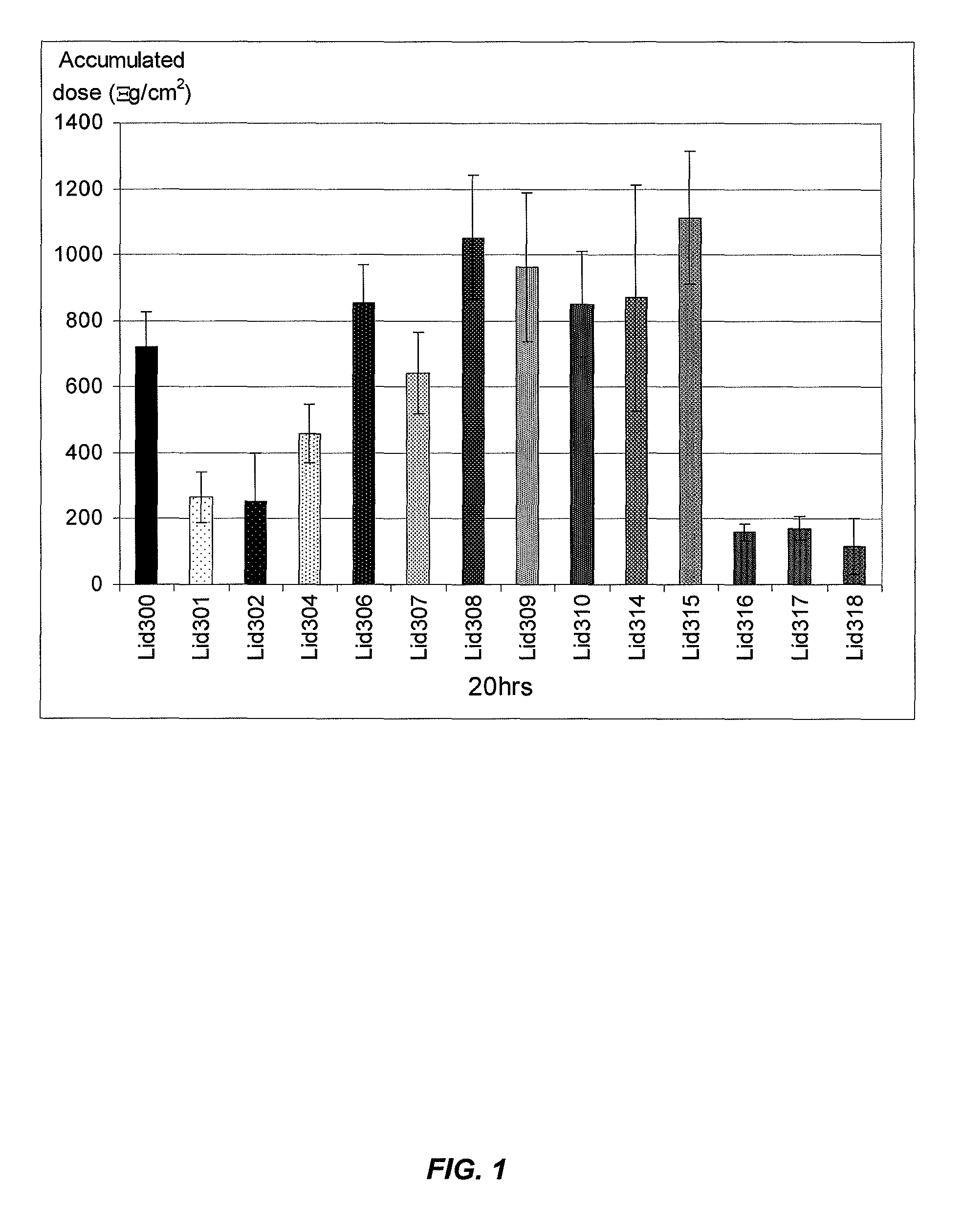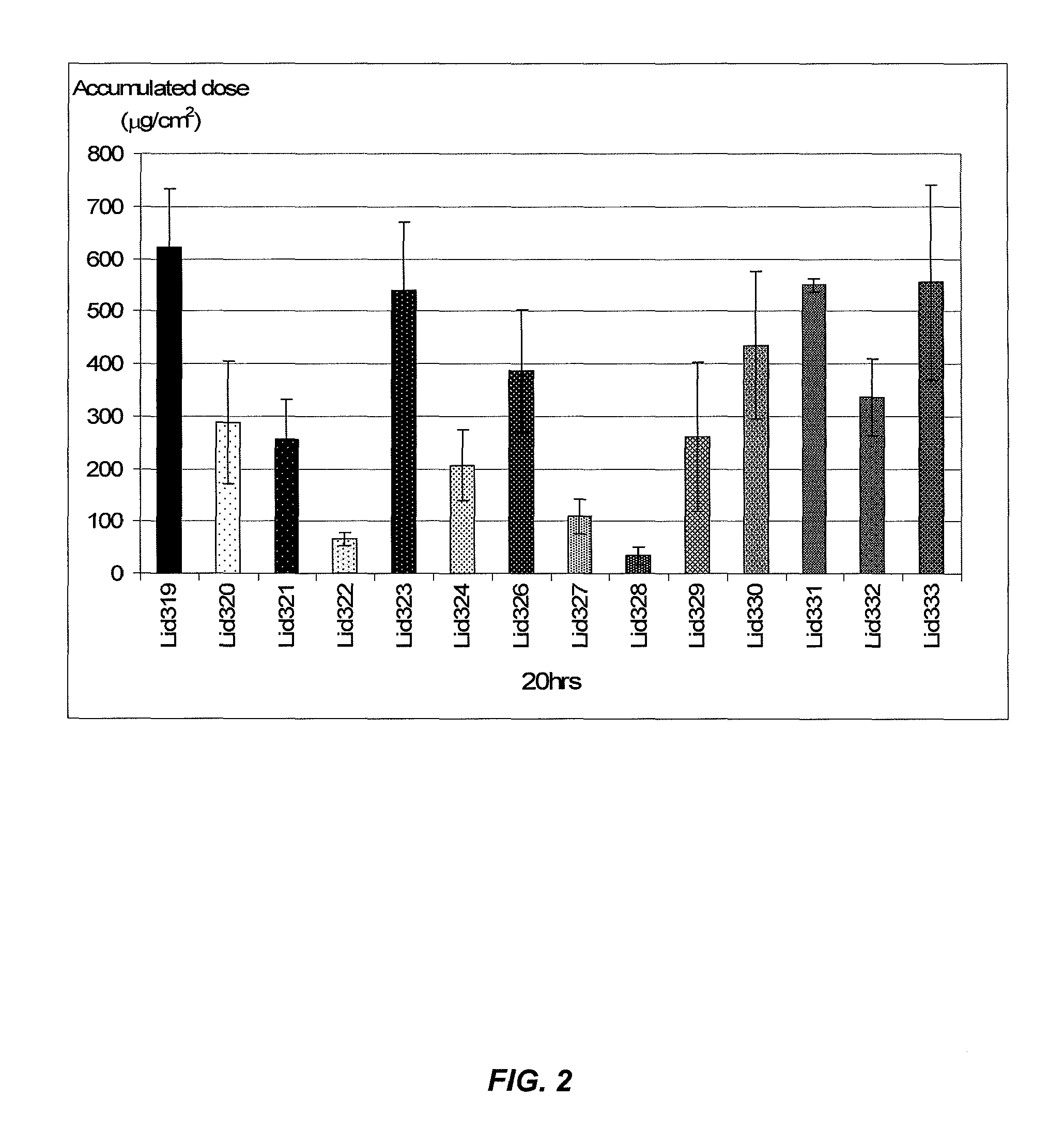Formulations for the treatment of acute herpes zoster pain
a herpes zoster and formulation technology, applied in the field of formulations and methods for treating pain associated with acute herpes zoster, can solve the problems of no fda-approved topical medication to treat the pain associated, increase risk, and alleviation of pain, and achieves the effects of less pain, limited skin area, and easy coverage of a wide area of the skin
- Summary
- Abstract
- Description
- Claims
- Application Information
AI Technical Summary
Benefits of technology
Problems solved by technology
Method used
Image
Examples
example 1
a) Methods
[0103]Franz diffusion cell (FDC) experiments were used to analyze lidocaine base and lidocaine hydrochloride flux rates from varying formulations across a substrate membrane.
[0104]Franz diffusion cells are a common and well known method for measuring transdermal flux rates. The general Franz cell procedure is described in Franz, T. J., Percutaneous absorption: on the relevance of in vitro data: J. Invest Derin, 64:190-195 (1975). The following was the methodology used in the present Examples.
[0105]Franz cells with a 3 ml receptor well volume were used in conjunction with split thickness cadaver skin (0.015″-0.018″, AlloSource), dermatomed porcine skin (Lampire Biologicals), or shed snake skin (Python regius). Porcine skin was used in the experiments depicted in FIGS. 1 and 3-9, snake skin was used in the experiments depicted in FIG. 2 and cadaver skin was used in the remaining experiments described herein. The donor well had an area of ˜0.5 cm2. Receptor wells were filled ...
example 2
Screening Varying Molecular Penetration Enhancers with Lidocaine Hydrochloride
[0119]Lidocaine hydrochloride (Lidocaine HCl) was also examined. As lidocaine HCl is more soluble in water than lidocaine base, it was possible to make formulations with a higher water component.
[0120]FIGS. 10 to 22 show the results of screening with lidocaine HCl in a water based vehicle with the incorporation of various molecular penetration enhancers. FIG. 10 shows that the flux of formulations using lidocaine HCl was noticeably lower than the L504 comparator (lidocaine base formulation), with the notable exception of LidHCl6. This formulation used AMP and GL as a penetration enhancement combination, leading to flux comparable to L504 with even though the water content was increased by ˜75%.
[0121]As shown in FIG. 11, the inclusion of AMP in the formulation led to a sharp increase in the flux (LidHCL8a vs LidHCL20a). FIG. 11 also shows the results of formulations in which the water was increased to ˜60%,...
example 3
Methodology to Prepare the Formulations
Preparation of Lidocaine HCL Solution Formulation (LidHCl 115a)
Composition:
[0134]
TABLE 3Lidocaine HCl10%w / wPropylene Glycol16.5%w / wPEG30010%w / wWater63.3w / wPropyl Paraben0.1%w / wMethyl Paraben0.1%w / w5N NaOH:adjust pH to 6.0
Procedure:
[0135]1. Combine propylene glycol, and PEG300.[0136]2. Add methyl and propyl paraben. Mix thoroughly until the parabens are completely dissolved. Heating the solution to 60° C. will facilitate this process.[0137]3. Add water to the mixture.[0138]4. Add lidocaine HCl to the mixture while stirring.[0139]5. After lidocaine HCl is fully dissolved, adjust the pH to 6.0 by dropwise adding 5N NaOH. Approximately 0.4 wt % NaOH is needed.
NOTE: Dropwise addition of 5N NaOH will cause localized crystallization of lidocaine, which will disperse after stirring. For scale-up, it maybe preferable to add less water than 63.3% and qs appropriately with a more dilute NaOH solution.
Preparation of Lidocaine HCL Solution Formulation (LidH...
PUM
| Property | Measurement | Unit |
|---|---|---|
| Fraction | aaaaa | aaaaa |
| Fraction | aaaaa | aaaaa |
| Fraction | aaaaa | aaaaa |
Abstract
Description
Claims
Application Information
 Login to View More
Login to View More - R&D
- Intellectual Property
- Life Sciences
- Materials
- Tech Scout
- Unparalleled Data Quality
- Higher Quality Content
- 60% Fewer Hallucinations
Browse by: Latest US Patents, China's latest patents, Technical Efficacy Thesaurus, Application Domain, Technology Topic, Popular Technical Reports.
© 2025 PatSnap. All rights reserved.Legal|Privacy policy|Modern Slavery Act Transparency Statement|Sitemap|About US| Contact US: help@patsnap.com



